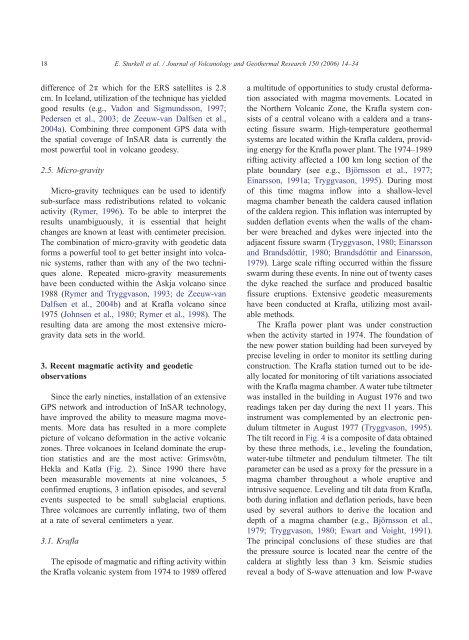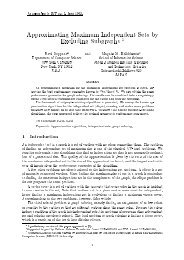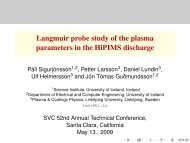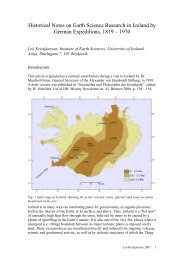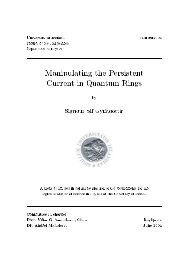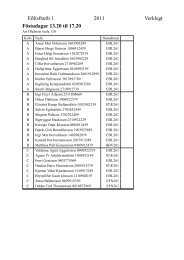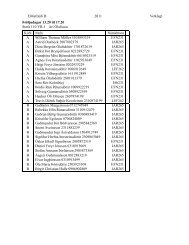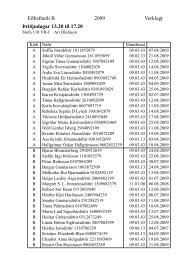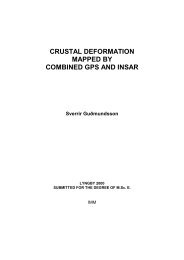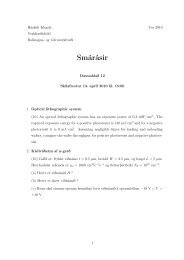Volcano geodesy and magma dynamics in Iceland - Acri-ST
Volcano geodesy and magma dynamics in Iceland - Acri-ST
Volcano geodesy and magma dynamics in Iceland - Acri-ST
Create successful ePaper yourself
Turn your PDF publications into a flip-book with our unique Google optimized e-Paper software.
18E. Sturkell et al. / Journal of <strong>Volcano</strong>logy <strong>and</strong> Geothermal Research 150 (2006) 14–34difference of 2k which for the ERS satellites is 2.8cm. In Icel<strong>and</strong>, utilization of the technique has yieldedgood results (e.g., Vadon <strong>and</strong> Sigmundsson, 1997;Pedersen et al., 2003; de Zeeuw-van Dalfsen et al.,2004a). Comb<strong>in</strong><strong>in</strong>g three component GPS data withthe spatial coverage of InSAR data is currently themost powerful tool <strong>in</strong> volcano <strong>geodesy</strong>.2.5. Micro-gravityMicro-gravity techniques can be used to identifysub-surface mass redistributions related to volcanicactivity (Rymer, 1996). To be able to <strong>in</strong>terpret theresults unambiguously, it is essential that heightchanges are known at least with centimeter precision.The comb<strong>in</strong>ation of micro-gravity with geodetic dataforms a powerful tool to get better <strong>in</strong>sight <strong>in</strong>to volcanicsystems, rather than with any of the two techniquesalone. Repeated micro-gravity measurementshave been conducted with<strong>in</strong> the Askja volcano s<strong>in</strong>ce1988 (Rymer <strong>and</strong> Tryggvason, 1993; de Zeeuw-vanDalfsen et al., 2004b) <strong>and</strong> at Krafla volcano s<strong>in</strong>ce1975 (Johnsen et al., 1980; Rymer et al., 1998). Theresult<strong>in</strong>g data are among the most extensive microgravitydata sets <strong>in</strong> the world.3. Recent <strong>magma</strong>tic activity <strong>and</strong> geodeticobservationsS<strong>in</strong>ce the early n<strong>in</strong>eties, <strong>in</strong>stallation of an extensiveGPS network <strong>and</strong> <strong>in</strong>troduction of InSAR technology,have improved the ability to measure <strong>magma</strong> movements.More data has resulted <strong>in</strong> a more completepicture of volcano deformation <strong>in</strong> the active volcaniczones. Three volcanoes <strong>in</strong> Icel<strong>and</strong> dom<strong>in</strong>ate the eruptionstatistics <strong>and</strong> are the most active: Grímsvötn,Hekla <strong>and</strong> Katla (Fig. 2). S<strong>in</strong>ce 1990 there havebeen measurable movements at n<strong>in</strong>e volcanoes, 5confirmed eruptions, 3 <strong>in</strong>flation episodes, <strong>and</strong> severalevents suspected to be small subglacial eruptions.Three volcanoes are currently <strong>in</strong>flat<strong>in</strong>g, two of themat a rate of several centimeters a year.3.1. KraflaThe episode of <strong>magma</strong>tic <strong>and</strong> rift<strong>in</strong>g activity with<strong>in</strong>the Krafla volcanic system from 1974 to 1989 offereda multitude of opportunities to study crustal deformationassociated with <strong>magma</strong> movements. Located <strong>in</strong>the Northern Volcanic Zone, the Krafla system consistsof a central volcano with a caldera <strong>and</strong> a transect<strong>in</strong>gfissure swarm. High-temperature geothermalsystems are located with<strong>in</strong> the Krafla caldera, provid<strong>in</strong>genergy for the Krafla power plant. The 1974–1989rift<strong>in</strong>g activity affected a 100 km long section of theplate boundary (see e.g., Björnsson et al., 1977;E<strong>in</strong>arsson, 1991a; Tryggvason, 1995). Dur<strong>in</strong>g mostof this time <strong>magma</strong> <strong>in</strong>flow <strong>in</strong>to a shallow-level<strong>magma</strong> chamber beneath the caldera caused <strong>in</strong>flationof the caldera region. This <strong>in</strong>flation was <strong>in</strong>terrupted bysudden deflation events when the walls of the chamberwere breached <strong>and</strong> dykes were <strong>in</strong>jected <strong>in</strong>to theadjacent fissure swarm (Tryggvason, 1980; E<strong>in</strong>arsson<strong>and</strong> Br<strong>and</strong>sdóttir, 1980; Br<strong>and</strong>sdóttir <strong>and</strong> E<strong>in</strong>arsson,1979). Large scale rift<strong>in</strong>g occurred with<strong>in</strong> the fissureswarm dur<strong>in</strong>g these events. In n<strong>in</strong>e out of twenty casesthe dyke reached the surface <strong>and</strong> produced basalticfissure eruptions. Extensive geodetic measurementshave been conducted at Krafla, utiliz<strong>in</strong>g most availablemethods.The Krafla power plant was under constructionwhen the activity started <strong>in</strong> 1974. The foundation ofthe new power station build<strong>in</strong>g had been surveyed byprecise level<strong>in</strong>g <strong>in</strong> order to monitor its settl<strong>in</strong>g dur<strong>in</strong>gconstruction. The Krafla station turned out to be ideallylocated for monitor<strong>in</strong>g of tilt variations associatedwith the Krafla <strong>magma</strong> chamber. A water tube tiltmeterwas <strong>in</strong>stalled <strong>in</strong> the build<strong>in</strong>g <strong>in</strong> August 1976 <strong>and</strong> tworead<strong>in</strong>gs taken per day dur<strong>in</strong>g the next 11 years. This<strong>in</strong>strument was complemented by an electronic pendulumtiltmeter <strong>in</strong> August 1977 (Tryggvason, 1995).The tilt record <strong>in</strong> Fig. 4 is a composite of data obta<strong>in</strong>edby these three methods, i.e., level<strong>in</strong>g the foundation,water-tube tiltmeter <strong>and</strong> pendulum tiltmeter. The tiltparameter can be used as a proxy for the pressure <strong>in</strong> a<strong>magma</strong> chamber throughout a whole eruptive <strong>and</strong><strong>in</strong>trusive sequence. Level<strong>in</strong>g <strong>and</strong> tilt data from Krafla,both dur<strong>in</strong>g <strong>in</strong>flation <strong>and</strong> deflation periods, have beenused by several authors to derive the location <strong>and</strong>depth of a <strong>magma</strong> chamber (e.g., Björnsson et al.,1979; Tryggvason, 1980; Ewart <strong>and</strong> Voight, 1991).The pr<strong>in</strong>cipal conclusions of these studies are thatthe pressure source is located near the centre of thecaldera at slightly less than 3 km. Seismic studiesreveal a body of S-wave attenuation <strong>and</strong> low P-wave


